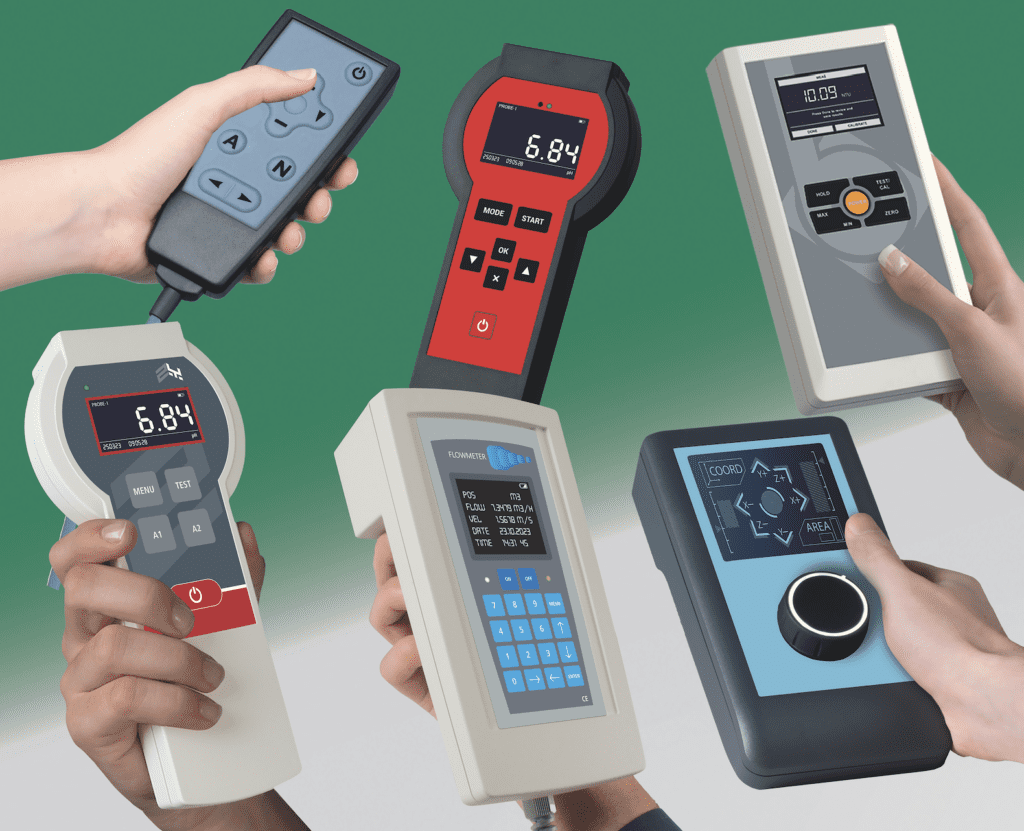
Advances in machine control, robotics and automation are fuelling demand for larger handheld devices. OKW explains how to specify the right housings.
Ergonomics are crucial regarding handheld electronics—and even more so when the device is larger than the human hand. The housing must be large enough to accommodate the electronics but comfortable to use for long periods.
There’s a fine line between ‘handheld’ and ‘portable’. Specify an enclosure too large and users will be happy enough to carry it but less enthusiastic about holding and operating it. The housing must be curved and tactile but still have a large flat operating area for a touch screen, membrane keypad or front panel assembly, along with other surfaces for buttons or connectors. Then there are questions of robustness and ingress protection.
In a world of standard handheld enclosures dominated by phone- sized cases and remote- control fobs, finding something bigger—geared to demanding industrial applications—can be tricky. Help is at hand. There are larger plastic enclosures designed to meet the technical requirements of factory life. They are discreet and versatile but still possess the right features for specialised roles.
These enclosures overcome ergonomics challenges by being well balanced, with a comfortable grip area, even if the large display surface on top stretches beyondthe palm and fingers of a normal human hand.
OKW Enclosures’ marketing director, Robert Cox, said: “Large handheld enclosures shouldn’t be bulky and cumbersome. With the right balance and contouring, they should make devices easy and convenient to use.” This design ethos is exemplified by Hand- Terminal, a large machine control enclosure available in two versions, one for membrane keypads the other for front panel assemblies. The back is contoured for comfort, while the top is flat. There is space for buttons on the sides, while the front is recessed to protect connectors.
Virtually all standard enclosures, handheld or otherwise, will require some form of customisation but the larger the range, the less machining is needed. This is the case with Datec- Mobil-Box. It is available in multiple versions to suit a range of displays including Type 2″-LC-Glass, Type 2 x 16 (standard or compact), Type 4 x 16 standard, Type 2 x 20 miniature and Types 4 x 20.
Power is always a crucial consideration so any larger handheld enclosure should offer the choice of either a cable or battery compartment, preferably with a wide selection of cell configurations. Datec-Control, which is designed to house larger display modules, has a large, rounded head that is counterbalanced by a long body which (depending on size) can accommodate two, three, four, five AA or one 9V batteries, along with PCMCIA holders.
In the past, many standard enclosures were moulded from ABS. It is a tried and trusted all-round plastic with high tensile strength and good resistance to chemicals. However, industrial applications call for something tougher, such as a polycarbonate/ABS blend.
Meanwhile, UV stability is a must for outdoor use. Enclosures such as Datec-Compact are moulded from UV-stable ASA+PC (UL94 V-0) in preference to ABS.
These enclosures are aimed at applications including mobile data recording, measurement and control, environmental technology and Industry 4.0. Many will be used outdoors. So, on versions with a battery compartment, SD cards and USB connectors can be inserted within the sealed area for added protection.
When specifying standard enclosures, it’s also important to think about accessories. For mobile devices, that means battery compartments, holders, clips, contacts and spacers. They will also likely need a docking station (for charging/ data transfer) or a wall holder. For cable-connected devices, there are cable grommets and strain relief clamps. Other options include soft-touch protectors that absorb impacts.
A good enclosure manufacturer will offer to assemble the accessories as a custom service. Other customisation options include CNC machining, lacquering, decor foils, printing of legends, logos and photo-quality graphics, special materials (such
as bespoke colours or V-0 plastics) and EMC shielding.
Choosing a single-source manufacturer that can carry out a full range of customisation services in-house ensures quality and accountability. It also saves money, shortens delivery times and reduces administration.
